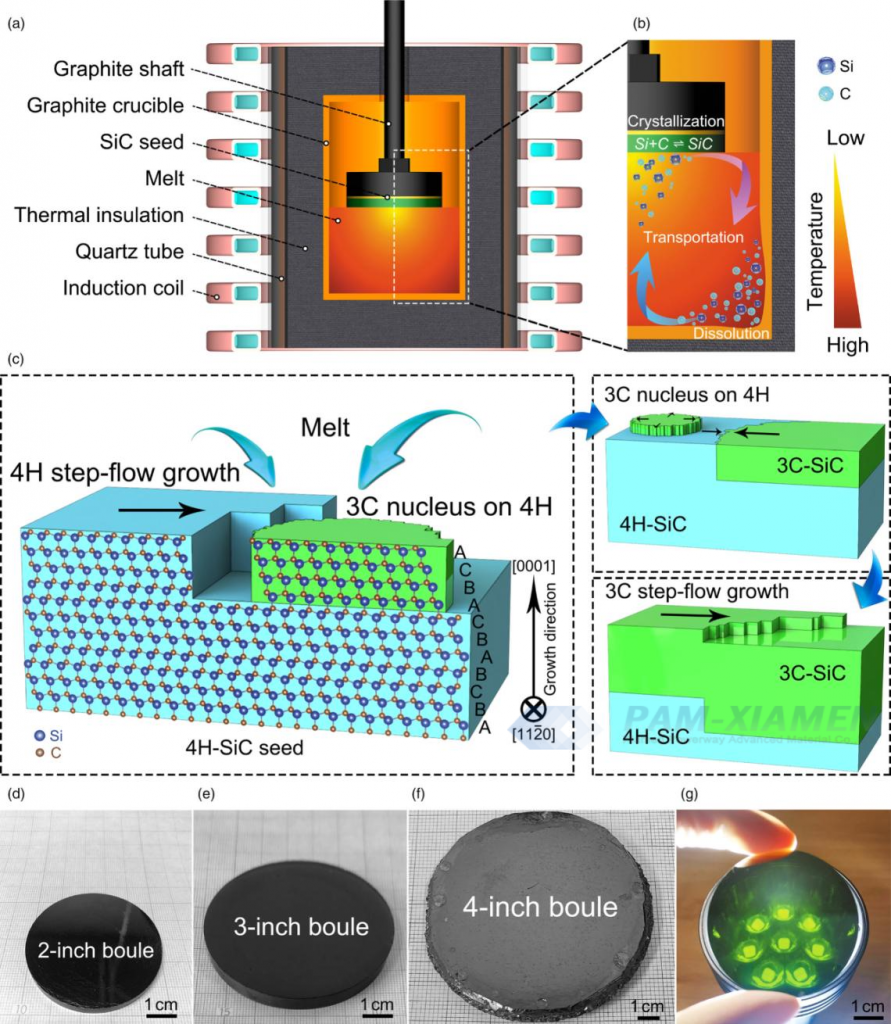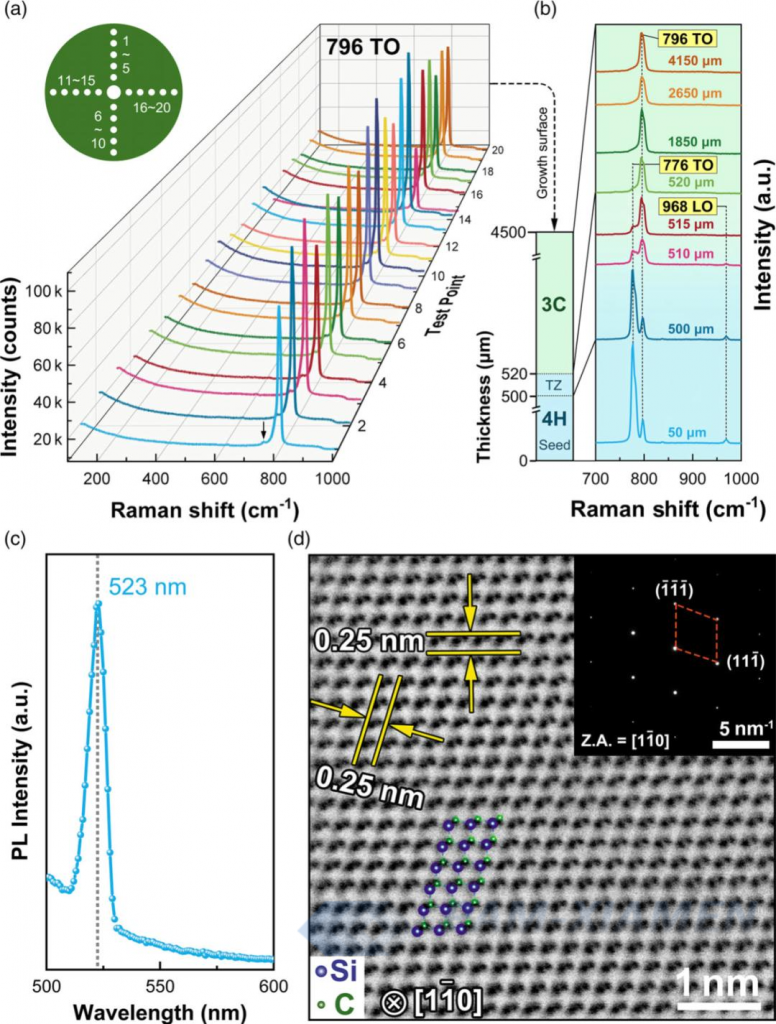Single crystal 3C-SiC substrate can be supplied with specifications as: https://www.powerwaywafer.com/3c-sic-wafer.html.
Silicon carbide (SiC) has excellent properties such as wide bandgap, high breakdown field strength, high saturation electron drift rate, and high thermal conductivity, and has important applications in fields such as new energy vehicles, photovoltaics, and 5G communication. Compared with the widely used 4H-SiC, cubic SiC (3C SiC) has higher carrier mobility (2-4 times), lower interface defect density of states (one order of magnitude lower), and higher electron affinity (3.7 eV). The use of 3C-SiC to prepare field-effect transistors can solve the problem of poor device reliability caused by multiple gate oxygen interface defects. But the progress of 3C-SiC based transistors is slow, mainly due to the lack of single crystal substrates. Previous studies have shown that 3C-SiC is prone to phase transition during growth, and existing growth methods cannot obtain crystals with a single crystal form.
1. Stable Growth of 3C-SiC Grown on 4H-SiC Via TSSG
According to the classical crystal growth theory, for smooth interface crystals, homogeneous two-dimensional nucleation needs to overcome critical potential barriers, with the existence of critical Gibbs free energy or supersaturation, while growth can occur at any small supersaturation. For heterogeneous nucleation, due to the introduction of new solid-solid interface energy, two-dimensional nucleation needs to overcome higher critical potential barriers. Therefore, under the same supersaturation, homogeneous nucleation and growth are significantly better in terms of energy than heterogeneous nucleation and growth, making the latter difficult to occur.
Recently, a research team has proposed the academic idea of regulating the solid-liquid interface energy to prioritize nucleation and growth on heterogeneous seed crystals compared to homogeneous seed crystals. Mainly including:
1) The lattice mismatch between the 3C (111)-melt and 4H (0001)-melt surfaces is small, and the solid-solid interface energy is very low;
2) The difference in Gibbs free energy between 4H and 3C bulk phases is relatively small;
3) If the interface energy of 3C (111) – melt is sufficiently low compared to that of 4H (0001) – melt by adjusting the melt composition, the two-dimensional nucleation and subsequent growth of Gibbs free energy are more favorable for the 3C phase.
قام الفريق بشكل مستقل بتصميم وبناء معدات اختبار للتوتر السطحي وزاوية التلامس الصلبة والسائلة المنصهرة ذات درجات الحرارة العالية جدًا. تم قياس التوتر السطحي لتركيبات مختلفة من الذوبان وزاوية التلامس بين الذوبان و4H-SiC و3C-SiC عند درجات حرارة عالية، كما تم قياس قانون الاختلاف لطاقة الواجهة الصلبة والسائلة بين 4H-SiC و3C-SiC وعالية. تم الحصول على ذوبان درجة الحرارة، والتحقق من جدوى تنظيم الطاقة واجهة. استخدم الفريق طريقة الطور السائل ذو درجة الحرارة العالية لتحقيق متطلبات طاقة أقل لـ Gibbs لـ 3C-SiC تحت نفس ظروف التشبع الفائق، مما يؤدي إلى قمع تحولات الطور أثناء النمو. لأول مرة على المستوى الدولي، تمت زراعة بلورات مفردة من 3C-SiC بقطر 2-4 بوصة، وسمك 4-10 مم، وشكل بلوري واحد، كما هو موضح في الشكل 1.

الشكل 1. تم تحقيق نواة غير متجانسة ونمو بلوري مستقر يبلغ 2-4 بوصات وسمك 4-10 مم 3C-SiC على بلورات بذور 4H-SiC باستخدام طريقة TSSG
2. خصائص TSSG Grown 3C-SiC Single Crystal
تشير قياسات التحليل الطيفي لتشتت رامان على طول اتجاه سمك البلورة إلى أنه في بداية النمو، تتشكل نواة 3C-SiC وتنمو على بلورة البذور 4H-SiC، مع منطقة تعايش أقل من 20 ميكرومتر. يؤكد الشكل 2 (أ ب) النظرية المذكورة أعلاه. يبلغ متوسط نصف عرض منحنى تأرجح الأشعة السينية على سطح النمو (111) 30 ثانية قوسية، مما يشير إلى أن 3C SiC المزروع يتمتع بجودة بلورية عالية. تبلغ مقاومة درجة حرارة الغرفة للبلورة المفردة 3C SiC 0.58 متر مكعب فقط، وهي 1/40 من مقاومة رقاقة 4H-SiC التجارية (15-28 متر مكعب مكعب) ومن المتوقع أن تقلل من فقدان الطاقة للجهاز.

الشكل 2: تحديد التركيب البلوري 3C-SiC. أ) حدد عشوائيًا 20 طيفًا من أطياف تشتت رامان من سطح النمو (111)، ويظهر الشكل الداخلي توزيع نقاط الاختبار على البلورة. ب) أطياف تشتت رامان على طول اتجاه سمك البلورة. ج) طيف التألق الضوئي (PL) يقاس عند 300 كلفن. د) صورة المجهر الإلكتروني النافذ (HAADF-STEM) ذات الزاوية العالية للمجال المظلم الحلقي. يوضح الرسم التوضيحي نمط حيود الإلكترون (SAED) للمنطقة المحددة على طول محور النطاق البلوري [110].
إن نمو البلورات المفردة من مستوى الرقاقة 3C-SiC يملأ الفجوة على المستوى العالمي، مما يجعل الإنتاج الضخم لبلورات 3C-SiC ممكنًا ويوفر فرصًا جديدة لتطوير أجهزة إلكترونية للطاقة عالية الأداء. وفي الوقت نفسه، فإن آلية النواة التفضيلية والنمو على بلورات البذور غير المتجانسة مقارنة ببلورات البذور المتجانسة توسع نظرية نمو البلورات التقليدية.
لمزيد من المعلومات، يرجى الاتصال بنا على البريد الإلكترونيvictorchan@powerwaywafer.com و powerwaymaterial@gmail.com.

